20th Combat Mapping Squadron
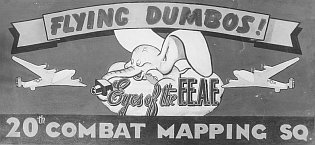 The 20th Combat Mapping Squadron's Flying Dumbos insignia dates to late 1942 when, as the 20th Photographic Mapping Squadron, it was being equipped with B-25's.
The 20th Combat Mapping Squadron's Flying Dumbos insignia dates to late 1942 when, as the 20th Photographic Mapping Squadron, it was being equipped with B-25's.
Contact: Chuck Varney
These pages are a tribute to the men of the 20th Combat Mapping
Squadron--to the hundreds of ground support personnel and to the air
crews who flew the missions.
Squadron Mission
- Long range aerial mapping and reconnaissance using F-7A and F-7B aircraft (B-24's converted for aerial photography)
- Radar intelligence gathering with B-24J ferrets
Lineage
- 20th Photographic Mapping Squadron
- Activated 23 August 1942, Colorado Springs, Colorado - 20th Photographic Squadron (Heavy)
- Redesignated 6 February 1943, Colorado Springs, Colorado - 20th Combat Mapping Squadron
- Redesignated 11 August 1943, Colorado Springs, Colorado - 20th Reconnaissance Squadron, Long Range, Photographic-RCM
- Redesignated 15 June 1945, Manila, Luzon, Philippine Islands
Overseas Designation, from April 1944 to 15 June 1945
- Far East Air Forces
- Fifth Air Force
- 91st Photographic Wing, Reconnaissance
- 6th Photographic Group, Reconnaissance
- 20th Combat Mapping Squadron
Oveseas Designation, from 15 June 1945
- Far East Air Forces
- Fifth Air Force
- 91st Reconnaissance Wing
- 6th Reconnaissance Group
- 20th Reconnaissance Squadron, Long Range, Photographic-RCM
Overseas Stations
- Sydney, Australia (ground echelon only)
- from October 1943 - Brisbane, Australia (ground echelon only)
- from November 1943 - Port Moresby, New Guinea (ground echelon only)
- from December 1943 - Nadzab, New Guinea
- from February 1944 (ground echelon) and from March 1944 ( air echelon) - Biak Island
- from September 1944 - Dulag, Leyte
- from November 1944 (ground echelon) - Tacloban, Leyte
- from January 1945 (based at Dulag, but air operations from Tacloban) - San Jose, Mindoro
- from February 1945 (air echelon only) - Clark Field, Luzon
- from May 1945 - Okinawa
- from August 1945
Campaigns
- Air Combat, Asiatic-Pacific Theater
- Air Offensive, Japan
- Bismark Archipelago
- China Defensive
- China Offensive
- Leyte
- Luzon
- New Guinea
- Ryukyus
- Southern Philippines
- Western Pacific
Service Streamers
- American Theater
Decorations
- Distinguished Unit Citation: Philippine Islands, 18-25 September 1944
- Philippine Presidential Unit Citation
Chronology
| Miscellaneous Events in the History of the 20th, 1942 - 2001 | |
| 23 Jul 42 | Activated: 20th Photographic Mapping Squadron (20th PMS) at Colorado Springs AAB, Colorado Springs, Colorado Initial strength: two officers and one enlisted man: 2nd Lts. Bernard Smith and Harold Hefflinger, and Pvt. James Ford |
| Activated: 4th Photographic Group (4th PG) at Colorado Springs AAB. (The 20th PMS was subordinate to the 4th PG) | |
| 18 Nov 42 | Squadron received its first aircraft, a North American B-25C-1 Mitchell, s/n 41-13244, named "Dat's All Brother" |
| 13 Dec 42 | Colorado Springs AAB renamed Peterson AAB in honor of 1st. Lt. Edward J. Peterson, Operations Officer of 10th Photo Recon Squadron, who was killed in an F-4 take-off crash on 8 Aug 42 |
| 9 Feb 43 | Reorganized: from 20th Photographic Mapping Squadron to 20th Photographic Squadron (Heavy) (20th PS (H)) |
| 5 Mar 43 | Peterson AAB assigned to Third Air Force. New mission: heavy bomber (B-24) combat crew training by the 214th Combat Crew Training School |
| 15 Aug 43 | Reorganized: from 20th Photographic Squadron (Heavy) to 20th Combat Mapping Squadron (20th CMS) |
| 1 Sep 43 | Squadron strength: 62 officers, 3 flying officers (F/O), 1 Warrant Officer and 383 enlisted men |
| 7 Sep 43 | Squadron ground echelon separated from air echelon (which remained at Peterson), in preparation for tranfer overseas |
| 25 Sep 43 | Ground echelon departed Camp Stoneman, California for Australia aboard USS Westpoint |
| 1 Oct 43 | Ground echelon strength: 10 officers, 1 Warrant Officer, and 268 enlisted men |
| 2 Oct 43 | Air echelon reassigned from Peterson Field, Colorado Springs, Colorado, to Will Rogers Field, Oklahoma City, Oklahoma, Third Air Force. |
| 10 Oct 43 | Ground echelon arrived Sydney, Australia |
| 11 Oct 43 | Ground echelon arrived Warwick Farms, Australia |
| 22 Nov 43 | Ground echelon departed Warwick Farms, Australia |
| 23 Nov 43 | Ground echelon arrived Doomben, Queensland, Australia |
| 1 Dec 43 | Ground echelon departed Doomben, Australia for Port Moresby, New Guinea aboard USS White |
| 10 Dec 43 | Squadron ground echelon arrived APO 923. Temporarily quartered at Pleasant Valley, Port Moresby, New Guinea |
| This date marks the start of the 20th Combat Mapping Squadron's New Guinea Campaign | |
| 11 Dec 43 | 20th Combat Mapping Squadron released from 4th Photographic Group and attached to 6th Photographic Group |
| 15 Dec 43 | Ground echelon moved to squadron area at Port Moresby, New Guinea |
| 10 Jan 44 | Air echelon ordered to move from Will Rogers Field, Oklahoma City, Oklahoma to Hunter Field, Savannah, Georgia for staging to the Pacific. |
| 13 Feb 44 | Ground echelon departed Port Moresby, New Guinea and arrived at Nadzab, New Guinea, APO 713 |
| 23 Feb 44 | At 2300 hours, this date, first crew and aircraft (Lt. Wooten's in F-7A 42-64047) of the 20th Combat Mapping Squadron air echelon departed Fairfield, California for New Guinea |
| 16 Mar 44 | The first crew and aircraft (Lt. Wilson's in F-7A 42-64051) of the 20th Combat Mapping Squadron air echelon arrived Nadzab, New Guinea |
| 5 Apr 44 | First combat mission flown by the 20th Combat Mapping Squadron: Hollandia, New Guinea by Rives' crew in F-7A 42-64200 and JH Wooten's crew in F-7A 42-64047 |
| 25 Jul 44 | First combat mission flown in an F-7B (44-40199) by the 20th Combat Mapping Squadron: to Wewak area, Maj. Davis, pilot |
| 3 Sep 44 | Squadron operating from Biak Island |
| 15 Nov 44 | Ground echelon at Dulag, Leyte. Air echelon remained at Biak |
| 25 Jan 45 | Air echelon, based at Dulag, Leyte, but operating from Tacloban, Leyte |
| 24 Feb 45 | Air echelon operating from San Jose, Mindoro |
| 17 May 45 | 20th Combat Mapping Squadron operating from Clark Field, Luzon |
| 15 June 45 | Redesignated: 20th Combat Mapping Squadron as the 20th Reconnaissance Squadron, Long Range, Photographic-RCM (20th RS, LR, P-RCM) |
| Redesignated: 6th Photographic Group, Reconnaissance as the 6th Reconnaissance Group | |
| 4 Aug 45 | Squadron operating from Okinawa |
| 18 Aug 45 | Sgt. Anthony J. Marchione, 20th RS aerial gunner,
killed by attacking Japanese fighters while flying reconnaissance over
Tokyo with the 312th BG, 386th BS in B-32 s/n 42-108578
S/Sgt. Joseph M. Lacharite, 20th RS aerial photographer, also aboard 42-108578, was wounded |
| 31 Aug 45 | Last recorded combat mission for the squadron in WW II: Mission number 243Z-1, 14 hr 10 min to Tokyo area by F-7B 44-42028 (Lt. Eisele), F-7B 44-42031 (Lt. Warren), F-7B 44-42135 (Lt. French), F-7B 44-42239 (Lt. Leeder), #269 (sic) (Lt. Essig), and F-7B 44-42350 (Capt. Gessner) |
| 2 Sep 45 | V-J Day. Japanese sign the instrument of surrender aboard USS Missouri anchored in Tokyo bay |
| Post War | |
| Until Jun 46 | Photo-mapped Japan as part of the War Department's Post Hostilities Mapping Project |
| 20 Jun 46 | Deactivated: 20th Reconnaissance Squadron, Long Range, Photographic-RCM |
| 11 Mar 47 | Redesignated: 20th Reconnaissance Squadron (Night Photographic) |
| 25 Jul 47 | Activated in the reserve |
| 27 Jun 49 | Redesignated: 20th Strategic Reconnaissance Squadron (Photographic Mapping) |
| 1 May 51 | Ordered to active service |
| 16 May 51 | Inactivated: 20th Strategic Reconnaissance Squadron (Photographic Mapping). |
| 14 Jan 54 | Redesignated: 20th Tactical Reconnaissance Squadron (Photographic) |
| 18 Mar 54 | Activated: 20th Tactical Reconnaissance Squadron (Photographic)
Flew RF-101C's over Cuba during Cuban Missile Crisis in the fall of 1962 Flew RF-101C's over North Vietnam, 1965-1967 |
| 1967 | Inactivated: 20th Tactical Reconnaissance Squadron (Photographic) |
| 1992 | Reactivated and Redesignated: 20th Air Intelligence Squadron |
| 1993- | Redesignated: 20th Intelligence Squadron |
F-7A, F-7B, and Ferret Aircraft
F-7A
The dozen aircraft delivered to the squadron for initial overseas deployment were type "F", model "7", series "A": F-7A. These were photographic conversions of B-24J's made at the Northwest Airlines Modification Center, St. Paul, Minnesota in the fall of 1943, and delivered to the squadron at Will Rogers Field, Oklahoma City, Oklahoma in January 1944. Features of the F-7A are listed below.
In the navigator/bombardier area:
- Windows and mounts for a tri-camera arrangement of one vertical and two oblique mapping cameras (this setup was called a trimetrogon, or a trimet, as it used three cameras, each with Bausch & Lomb's Metrogon lens)
- A modified bombardier's panel, serving as a local control point for the trimetrogon cameras
- An intervalometer to simultaneously trigger the trimetrogon shutters at a dialed-in interval
In the forward bomb bay:
- Auxiliary fuel tanks, port and starboard, for increased range
- Bomb bay lights
Aft bomb bay converted to camera bay:
- Bomb racks removed
- Bomb bay doors fixed shut
- Level floor installed
- Windows and mounts for cameras at a vertical station (starboard) and a split vertical station (port) in the forward end of the bay
- Aerial photographer's viewfinder and chair aft of the starboard camera station
- Main camera control panel to the right of the photographer's seat
- Intervalometers for the two camera bay stations
- A work table and racks for camera magazines and film rolls in the aft corners of the bay
- Camera vacuum circuit, bay heaters, overhead lighting, and intercomm connections
In side views, F-7A's can be identified by the oblique camera windows below the navigator compartment side windows.
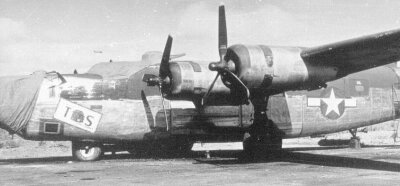 An
F-7A. This is 42-64051, "T.S.", with the blue reconnaissance
camouflage paint half removed,
late May or early June 1944. Note the prominent left oblique camera
window and its surrounding patch in the nose area (vertically below the
navigator's window
and to the left of the nose art)..
An
F-7A. This is 42-64051, "T.S.", with the blue reconnaissance
camouflage paint half removed,
late May or early June 1944. Note the prominent left oblique camera
window and its surrounding patch in the nose area (vertically below the
navigator's window
and to the left of the nose art)..
In May 1944, after barely seven weeks of combat operations, the squadron wrote a three-page report titled: Analysis and Recommendations regarding the F-7A type aircraft assigned to the 20th Combat Mapping Squadron, 6th Photo Group, Rcn. It included these two sentences:
"...The Tri-Metrogon set-up is inadequately protected. No provision has been made to protect the vertical camera from jarring or inadvertently stepping on it while entering the nose turret. The camera as a result, has to be realigned before each flight, also the extremely crowded conditions in the nose makes changing magazines exceedingly difficult...", and "...[The] F-7A type aircraft is inadequate in its present camera arrangement...".
These shortcomings were rectified with delivery of the first of the squadron's F-7B's in July 1944. In these, the three nose-mounted cameras of the F-7A were relocated to the aft end of the camera bay, thus consolidating all the camera equipment in one space.
In side views, F-7B's can be identified by the oblique camera windows near the rear edge of the aft bomb bay doors, one each side--and no camera windows in the nose.
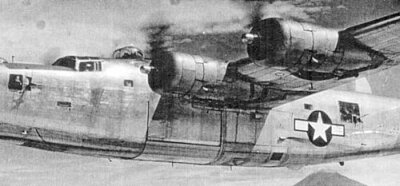 An
F-7B. This is 44-42031 over Japan after the war. (Mt. Fuji is in the
background.) Note the left oblique trimetrogon window at the rear of the
camera bay and the window for the split vertical station forward of it,
in the belly.
An
F-7B. This is 44-42031 over Japan after the war. (Mt. Fuji is in the
background.) Note the left oblique trimetrogon window at the rear of the
camera bay and the window for the split vertical station forward of it,
in the belly.
(Photo: Garland Bullock, navigator in 031)
In April and May 1945, five F-7B's equipped with H2X radar were delivered to the squadron. H2X, in production as AN/APS-15, was an X-band (3 cm) radar designed to implement through-the-clouds bombing. In its F-7B embodiment, H2X was a navigation radar; that is, its radar screen displayed a picture of the ground. The retractable H2X scanning antenna was installed in place of the ball turret.
In the 20th's F-7B/H2X aircraft, a radar repeater scope was installed in the camera bay and photographed with a K-24 5" x 5" format camera. The idea was to provide bomber crews with radar screen photos which they could use in conjunction with aerial photos to identify their targets. In practice, the majority of missions flown by the squadron's H2X-equipped F-7B's were for conventional aerial photography and carried no H2X operator (Radar Observer, Bombardment).
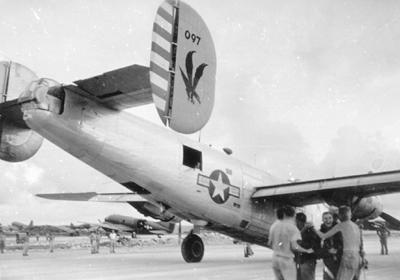 An
F-7B with H2X. This is 44-42097, photographed on Okinawa, 20 September
1945. It has just landed without the nose gear locked down. The
retracted H2X scanner dome is visible in the position normally occupied
by the ventral ball turret. (See also 44-42031 above for a retracted H2X
dome.) Forward of it is the right oblique camera window for the
trimetrogon (below the trailing edge of the flap).
An
F-7B with H2X. This is 44-42097, photographed on Okinawa, 20 September
1945. It has just landed without the nose gear locked down. The
retracted H2X scanner dome is visible in the position normally occupied
by the ventral ball turret. (See also 44-42031 above for a retracted H2X
dome.) Forward of it is the right oblique camera window for the
trimetrogon (below the trailing edge of the flap).
The following table lists all the squadron's F-7A's and F-7B's, their serial numbers, and
the B-24 series and block they were converted from. The table accounts
for all combat zone sorties (1132 total) recorded in the squadron
Mission Reports and/or Final Mission Reports.
| Serial Number | Converted | Aircraft Name | Combat Sorties | |||
|---|---|---|---|---|---|---|
| From | To | First | Last | Total | ||
| 42-64047 | B-24J-1-CF | F-7A | Patched Up Piece | 5 Apr 44 | 2 Sep 44 | 32 |
| 42-64048 | B-24J-1-CF | F-7A | The Wango Wango Bird | 6 May 44 | 18 Jun 44 | 4 |
| 42-64050 | B-24J-1-CF | F-7A | Little Joe |
8 Apr 44 | 3 Aug 44 | 14 |
| 42-64051 | B-24J-1-CF | F-7A | T.S. | 8 Apr 44 | 16 Jul 44 | 11 |
| 42-64053 | B-24J-1-CF | F-7A | Hangover Haven II | 22 Apr 44 | 16 Jan 45 | 38 |
| 42-64054 | B-24J-1-CF | F-7A | - - - |
16 Apr 44 | 30 May 45 | 71 |
| 42-64056 | B-24J-1-CF | F-7A | - - - | - - - | - - - | 0 |
| 42-64172 | B-24J-5-CF | F-7A | St. Louis Blues | 6 May 44 | 9 Sep 44 | 16 |
| 42-64177 | B-24J-5-CF | F-7A | Soldiers' Bonus | 2 Apr 45 | 12 May 45 | 27 |
| 42-64180 | B-24J-5-CF | F-7A | - - - | 28 Mar 45 | 29 Apr 45 | 18 |
| 42-64200 | B-24J-5-CF | F-7A | - - - | 5 Apr 44 | 3 Sep 44 | 14 |
| 42-64249 | B-24J-10-CF | F-7B | - - - | 10 Aug 44 | 29 Jan 45 | 41 |
| 42-64260 | B-24J-10-CF | F-7B | - - - | 22 Aug 44 | 7 Apr 45 | 5 |
| 42-73031 | B-24J-5-CO | F-7A | - - - | 29 May 44 | 27 Jul 44 | 9 |
| 42-73034 | B-24J-5-CO | F-7A | - - - | 7 Jul 44 | 7 Jul 44 | 1 |
| 42-73042 | B-24J-5-CO | F-7A | - - - | 16 Apr 44 | 16 Apr 44 | 1 |
| 42-73044 | B-24J-5-CO | F-7A | - - - | 22 May 44 | 22 May 44 | 1 |
| 42-73045 | B-24J-5-CO | F-7A | American Beauty | 2 May 44 | 11 Sep 44 | 19 |
| 42-73047 | B-24J-5-CO | F-7A | The Rip Snorter | 15 Apr 44 | 27 Jul 44 | 12 |
| 42-73048 | B-24J-5-CO | F-7A | Bourbon Boxcar | 15 May 44 | 15 May 44 | 2 |
| 42-73049 | B-24J-5-CO | F-7A | Photo Queen | 22 Apr 44 | 1 Aug 44 | 13 |
| 42-73052 | B-24J-5-CO | F-7A | Under Exposed | 14 May 44 | 22 May 44 | 2 |
| 42-73053 | B-24J-5-CO | F-7A | - - - | - - - | - - - | 0 |
| 44-40198 | B-24J-150-CO | F-7B | Cherokee Strip | 10 Aug 44 | 20 Apr 45 | 106 |
| 44-40199 | B-24J-150-CO | F-7B | - - - | 25 Jul 44 | 29 Mar 45 | 100 |
| 44-40422 | B-24J-160-CO | F-7B | - - - | 8 Aug 44 | 30 Sep 44 | 14 |
| 44-40423 | B-24J-160-CO | F-7B | Idle Curiosity | 9 Aug 44 | 4 Oct 44 | 17 |
| 44-40602 | B-24J-170-CO | F-7B | - - - | 9 Aug 44 | 18 Dec 44 | 52 |
| 44-40625 | B-24J-170-CO | F-7B | - - - | 26 Aug 44 | 1 Oct 44 | 18 |
| 44-40659 | B-24J-175-CO | F-7B | - - - | 29 Aug 44 | 25 Jan 45 | 61 |
| 44-40669 | B-24J-175-CO | F-7B | - - - | 1 Jul 45 | 1 Jul 45 | 1 |
| 44-40847 | B-24J-180-CO | F-7B | - - - | 5 Oct 44 | 13 May 45 | 79 |
| 44-40895 | B-24J-185-CO | F-7B | - - - | 25 Sep 44 | 25 Nov 44 | 35 |
| 44-40961 | B-24J-190-CO | F-7B | - - - | 9 Oct 44 | 11 Jan 45 | 50 |
| 44-41013 | B-24J-190-CO | F-7B | - - - | 14 Oct 44 | 28 Aug 45 | 105 |
| 44-41943 | B-24M-5-CO | F-7B | (with H2X radar) | 7 May 45 | 29 Aug 45 | 27 |
| 44-42026 | B-24M-10-CO | F-7B | (with H2X radar) | 6 May 45 | 7 May 45 | 2 |
| 44-42028 | B-24M-10-CO | F-7B | (with H2X radar) | 17 May 45 | 31 Aug 45 | 25 |
| 44-42031 | B-24M-10-CO | F-7B | (with H2X radar) | 16 Jun 45 | 31 Aug 45 | 11 |
| 44-42097 | B-24M-15-CO | F-7B | (with H2X radar) | 30 Apr 45 | 30 Aug 45 | 33 |
| 44-42135 | B-24M-15-CO | F-7B | - - - | 25 Aug 45 | 31 Aug 45 | 4 |
| 44-42239 | B-24M-20-CO | F-7B | Mary Lou | 25 Aug 45 | 31 Aug 45 | 4 |
| 44-42265 | B-24M-25-CO | F-7B | - - - | 25 Aug 45 | 30 Aug 45 | 3 |
| 44-42328 | B-24M-25-CO | F-7B | - - - | 14 Aug 45 | 28 Aug 45 | 5 |
| 44-42350 | B-24M-30-CO | F-7B | - - - | 18 Aug 45 | 31 Aug 45 | 5 |
| 44-42373 | B-24M-30-CO | F-7B | - - - | 14 Aug 45 | 29 Aug 45 | 6 |
| 44-42376 | B-24M-30-CO | F-7B | - - - | 15 Aug 45 | 30 Aug 45 | 8 |
| 44-42387 | B-24M-30-CO | F-7B | - - - | 29 Aug 45 | 30 Aug 45 | 2 |
| Unidentified | --- | F-7A/ B | - - - | 8 Apr 44 | 31 Aug 45 | 8 |
F-7 Crews
From late April 1944 until mid-February 1945, F-7A's and -B's were operated with 11-man crews. After that, 10-man crews, using four instead of five gunners, were used.
In the crew list below, the common Military Occupational Specialty code and title for each crew position is given in parentheses.
- Pilot (1024 Pilot, Four-engine Aircraft)
- Copilot (1024 Pilot, Four-engine Aircraft)
- Navigator (1034 Navigator)
- Flight Engineer (748 Army Airplane Mechanic-Gunner, Flight Engineer)
- Radio Operator (757 Radio Operator-Mechanic-Gunner)
- Photographer (939 Aerial Photographer-Gunner)
- Nose Turret Gunner (611 Aerial Gunner or 612 Airplane Armorer-Gunner)
- Ball Turret Gunner (611 Aerial Gunner or 612 Airplane Armorer-Gunner)
- Two Waist Gunners (611 Aerial Gunner or 612 Airplane Armorer-Gunner)
- Tail Turret Gunner (611 Aerial Gunner or 612 Airplane Armorer-Gunner)
All enlisted crewmembers were trained as aerial gunners.
In mid-June 1945 the squadron primary mission was changed from combat mapping to photographic and radar reconnaissance. As a result, the 20th Combat Mapping Squadron was redesignated as the 20th Reconnaissance Squadron, Long Range, Photo-RCM. To execute the RCM (Radar Countermeasures) mission the squadron received four B-24J ferret aircraft: Ferrets #10, #11, #12, and #13. Ferret #13 came from prior service with the 308th BG, Fourteenth Air Force, in China. Ferret #12 previously served with the 7th BG, Tenth Air Force, in India. Ferrets #10 and #11 operated in the SWPA before being assigned to the 20th.
The 20th's ferret missions were flown to detect Japanese radar installations, pinpoint locations and determine intercepted radar characterisitcs (transmitter frequency, pulse repetition frequency, and pulse width). This intelligence could then be used to find and destroy, or to jam, those same sites.
Ferret modifications to B-24's were similar to those of F-7's in that bombing equipment was removed, auxiliary fuel tanks were installed in the front bomb bay, and the rear bomb bay was converted into equipment space. Entries in the ferret flight Final Mission Reports indicate these aircraft carried sufficient gear to scan the radio spectrum from .55-6000 Mc/s (MHz). Specific equipment identified, due to failure of it, included: AN/APR-5A (Radar Search Receiver, 1000-6000 Mc/s), AN/APA-11 (Radar Pulse Analyzer), and SCR-717C (10-cm Air-to-Surface Vessel radar, used for navigation). D/F (direction finding) is mentioned in each mission report, but no specific type of equipment is mentioned.
The following table lists the ferret serial numbers, the
B-24 series they were converted from, the ferret numbers, and number of
sorties flown.
| Serial Number | Converted | Aircraft Name | Combat Sorties | |||
|---|---|---|---|---|---|---|
| From | To | First | Last | Total | ||
| 44-40815 | B-24J-180-CO | Ferret #12 | Alec Tronix | 10 Jul 45 | 24 Jul 45 | 4 |
| 44-40817 | B-24J-180-CO | Ferret #13 | Rovin' Lady | 2 Aug 45 | 5 Aug 45 | 2 |
| 44-40943 | B-25J-185-CO | Ferret # 11 | - - - | 3 Jul 45 | 4 Jul 45 | 2 |
| 44-41076 | B-24J-195-CO | Ferret #10 | - - - | 11 Jul 45 | 6 Aug 45 | 4 |
Of the 12 ferret sorties flown before war's end, two were the squadron's longest: 15 hours 45 minutes, and 15 hours 20 minutes (to Formosa and Hong Kong). Ten of the 12 sorties were flown directly from Clark Field, Luzon. The remaining two, to islands between Okinawa and Kyushu, were staged from Yontan Strip, Okinawa, to maximize available time over target.
The following table summarizes the 20th Combat Mapping Squadron's aircraft losses. Source
is monthly Squadron History reports unless otherwise noted.
| Date | Aircraft | Location / Casualties |
|---|---|---|
| 4 Dec 1943 | 42-40494 (F-7) | Crashed near Elverson, Pennsylvania while on a night cross-country training mission. Ten (10) casualties and one (1) survivor: |
| 7 Mar 1944 | 42-73053 (F-7A) | Aircraft destroyed at Nandi, Fiji, en-route to Nadzab, New Guinea. No casualties. |
| 29 Mar 1944 | 42-64056 (F-7A) | Crashed over Pacific one hour after departing Fairfield, California, en-route to Hawaii. Eight casualties: four (4) ATC and four (4) 20CMS ground crew personnel. Two (2) parachuted to safety. |
| 16 Apr 1944 | 42-73042 (F-7A) | Destroyed landing at Saidor, New Guinea. No casualties. |
| 22 May 1944 | 42-73052 (F-7A) | In early morning darkness, crashed near the peak of Mt. Wilhelm on the way to a mission. Eleven (11) casualties. |
| 9 Jun 1944 | 42-73044 (F-7A) | Destroyed landing at Saidor, New Guinea. Blew a tire, slid into embankment and burned. Eight (8) casualties and two (2) survivors: |
| After 17 Jun 1944 | 42-64048 (F-7A) | Last combat mission was flown to Wewak on 18 June 1944. This is unsubstantiated: destroyed landing at Nadzab, New Guinea on ferry mission. |
| 30 Sep 1944 | 44-40422 (F-7B) | Lost returning from mission to Philippines. Eleven (11) casualties |
| 4 Oct 1944 | 44-40423 (F-7B) | Destroyed landing Biak, after damaging nose gear taking off. Pilot, Rives. No casualties. [Source: 20CMS Mission Reports] |
| 25 Nov 1944 | 44-40895 (F-7B) | Destroyed on ground by air raid, Morotai. [Source: 20CMS Mission Reports] |
| 11 Jan 1945 | 44-40961 (F-7B) | Lost on mission. Last heard over Mindanao. Eleven (11) casualties. |
| 29 Jan 1945 | 42-64249 (F-7B) | Destroyed on ground Tacloban, Leyte. A C-46, taking off, crashed into 44-40659 and another C-46. The three exploded, causing 42-64249 to catch fire and explode. No casualties (unoccupied). |
| 29 Jan 1945 | 44-40659 (F-7B) | Destroyed on ground at Tacloban, Leyte. A C-46, taking off, crashed into 44-40659 and another C-46. The three exploded. Three (3) casualties. |
| 2 Apr 1945 | 44-40199 (F-7B) | Destroyed while taxiing at McGuire Strip, Mindoro. Ran into a ditch while avoiding another aircraft. No injuries. |
| 21 Apr 1945 | 44-40198 (F-7B) | Crashed on test flight over water, N.W. of San Theresa Village, Mindoro. Number 2 engine caught fire. The three (3) crewmembers parachuted to safety. Picked up in water (no life vests or rafts) one hour later. |
| 8 May 1945 | 44-42026 (F-7B) | Destroyed taking off from McGuire Strip, Mindoro. Nose gear collapsed. No casualties. |
| 10 May 1945 | 42-64180 (F-7A) | Destroyed on ground by 44-41322 of the 319BS landing at McGuire Strip, Mindoro. No casualties. |
| 13 May 1945 | 44-40847 (F-7B) | Severely damaged landing McGuire Strip, Mindoro. No casualties. |
| 25 May 1945 | 42-73047 (F-7A) | Destroyed at Boroke Strip, Biak. No accident details. One (1) casualty. |
Aerial Cameras
AERIAL CAMERA TYPES K-17, K-18, K-19B, AND K-22
The 20th did nearly all its aerial photography with two camera types: the K-17 and K-18. The K-17 was a 9" x 9" format (negative size) mapping and reconnaissance camera. It had three major components: a body, containing most of the mechanics and controls; a detachable magazine for 9 1/2" wide roll film; and a lens cone, with 6", 12", or 24" focal length options. The K-17, like the other three cameras in this section, was developed and built by the Fairchild Camera and Instrument Company.
The K-18 reconnaissance camera differed markedly from the K-17 in construction. The K-18 body and lens cone were built as a single unit housing a 24" focal length lens. Film format was 9" x 18".
A handful of night photography missions were flown with K-19B cameras in June and July 1945. The K-19B had a 12" lens, was of 9" x 9" format, and had a shutter that was operated by an attached photocell unit. The K-17, K-18, and K-19B all employed between-the-lens shutters.
The squadron was provided an abundance of K-22 cameras, but never used them for a combat mission, having found them "...unsuitable for mapping and not entirely satisfactory for reconnaissance..." (Interestingly, the F-7A's and B's were designed for a pair of K-22's to be mounted at the camera bay split vertical station.) The K-22 was a 9" x 9" format camera with lens cone options of 6", 12", 24", and 40" focal length. Unlike the others, its shutter was a focal plane type.
All these cameras were normally operated from a 24 VDC electrical source, but could be manually operated by a hand crank and shutter lever (the K-22 was electrical only). Each was fitted with a connector for an intervalometer that fired the camera at an interval set by the aerial photographer.
All used a vacuum applied to the film magazine to flatten the film surface before each exposure.
While these cameras were normally clamped into mounts, a pair of handles and a viewfinder could be fitted to K-17's and K-18's for hand-held operation. What "hand-held" meant is subject to interpretation, as these cameras were not lightweights. With a 200 foot roll of film, the A-5 film magazine used with the K-17 weighed 30 pounds. A complete K-17 with 12" lens cone and a full magazine weighed about 55 pounds. With a 24" lens instead of the 12", the weight climbed to near 75 pounds.
All four of these cameras used 9 1/2" wide Eastman Aerial Safety film. Film emulsions were Class L and Class N. Class L was the "normal" high-speed panchromatic film. Type N was labeled extra high-speed panchromatic, and was used for night photography in the K-19B's. The common lengths of film rolls were 200 feet and 75 feet. (Two hundred feet was the maximum film load for an A-5 or A-5A magazine. The A-7 magazines used with K-18 cameras held a maximum of 75 feet.)
K-17 Reconnaissance and Mapping Camera Data
The K-17 was the most common--and versatile--of the Army Air Force aerial cameras. With the 6" focal length Metrogon lens, it was the standard mapping (also called charting, or cartographic) camera of its day--and its day extended to long after the war. This was the combination used by the 20th in its trimetrogon setups.
The 20th did some reconnaissance photography with the K-17 and 12" lens late in the war, but for the most part the K-17's were used for mapping with the 6" Metrogon lens. (The combination of a 6" lens and 9" x 9" negative remains the mapping standard in the U.S. to this day.)
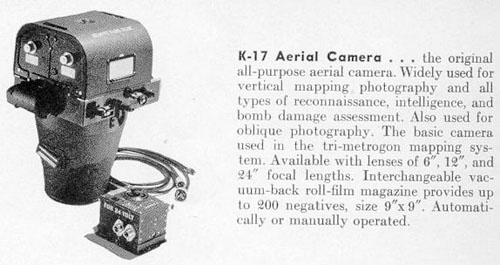
K-17 with 12" lens cone and A-5 or A-5A film magazine.
__________________________________________________________
Format: 9" x 9"
Lenses: 6" f.l. - f/6.3 - 73.74° x 73.74° view angle
12" f.l. - f/5.0 - 41.11° x 41.11° view angle
24" f.l. - f/6.0 - 21.24° x 21.24° view angle
Shutter: Between the lens
6" - 1/50, 1/100, 1/200, 1/300 second
12" - 1/75, 1/150, 1/225 second
24" - 1/50, 1/100, 1/150 second
Operation: Manual or electrical
Cycle time: 3 seconds, frame-to-frame
Magazine: A-5 or A-5A - 200 feet - 250 exposures
___________________________________________________________
K-18 Medium to High Altitude Reconnaissance Camera Data
The K-18 was one of the two workhorses of the 20th CMS--and of the Army Air Forces in general. (The other was the K-17.)
The 20th generally installed two K-18's in the camera bay; one each at the vertical and split vertical stations. Orientation was with the 18" image dimension transverse to the flight path.
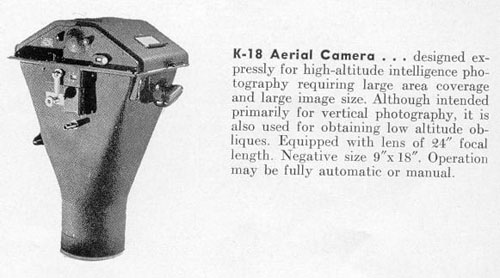
The description is of a K-18, but the photo is actually of the K-18's manual-operation-only
predecessor, the K-7C.
___________________________________________________________
Format: 9" x 18"
Lens: 24" f.l. - f/6.0 - 21.24° x 41.11° view angle
Shutter: Between the lens
1/50, 1/100, 1/150 second
Operation: Manual or electrical
Cycle time: 8 seconds, frame-to-frame
K-18A (late-war): 3 seconds, frame-to-frame
Magazine: A-7 - 75 feet - 45 exposures
A-8 - 390 feet - 245 exposures
___________________________________________________________
K-19B Night Reconnaissance Camera Data
A few night photography missions were successfully flown using the K-19B in 1945. The June 1945 Squadron History report cites success at 12,000 feet with the flash bombs (used to illuminate ground targets) set for 3,000 feet. Shutter speed was 1/50 second. The shutter in K-19's was triggered by a photocell which detected the flash bomb ignition.
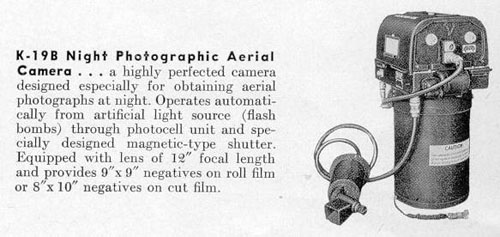
K-19B with A-5A film magazine. Photocell unit is attached.
___________________________________________________________
Format: 9" x 9"
Lens: 12" f.l. - f/2.5 - 41.11° x 41.11° view angle
Shutter: Between the lens
1/25, 1/50, 1/100 second
Operation: Electrical. Shutter light-activated via photocell
Cycle time: 3 seconds, frame-to-frame
Magazine: A-5 or A-5A - 200 feet - 250 exposures
___________________________________________________________
K-22 Reconnaissance and Charting Camera Data
The K-22 with 24" lens cones were the cameras delivered in the split vertical mounts of all F-7A's and B's the 20th received new--but the squadron never used them for a combat mission.
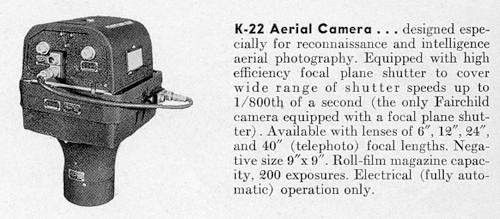
K-22 with 12" lens cone and A-5A film magazine.
___________________________________________________________
Format: 9" x 9"
Lens: 6" f.l. - f/6.3 - 73.74° x 73.74° view angle
12" f.l. - f/5.0 - 41.11° x 41.11° view angle
24" f.l. - f/6.5 - 21.24° x 21.24° view angle
40" f.l. - f/5.0 - 12.84° x 12.84° view angle
40" f.l. - f/5.6 - 12.84° x 12.84° view angle
40" f.l. - f/8.0 - 12.84° x 12.84° view angle
Shutter: Focal plane
A curtain: 1/135, 1/300 second
B curtain: 1/400, 1/800 second
Operation: Electrical
Cycle time: 3 seconds, frame-to-frame
Magazine: A-5 or A-5A - 200 feet - 250 exposures
___________________________________________________________
OTHER FAIRCHILD AERIAL CAMERAS: K-20 and F-56
K-20 Low Altitude Oblique, Hand-held Camera Data
There is no mention of the K-20 being used in any of the 20th's monthly reports, but they were probably carried and occasionally used for hand-held oblique shots.
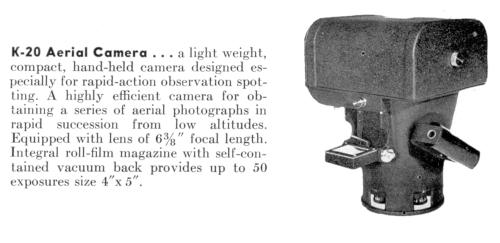
K-20 hand-held aerial camera.
___________________________________________________________
Format: 4" x 5"
Lens: 6.375" f.l. - f/4.5 - 34.84° x 42.83° angle of view
Shutter: Between the lens
1/125, 1/250, 1/500 second
Operation: Manual
Magazine: Part of camera, 20 feet - 50 exposures
___________________________________________________________
F-56 Reconnaissance Camera Data
The Navy's F-56 series was not generally used by the Army Air Forces, but is included here to round out the stable of large aerial frame cameras that Fairchild built during WW II.
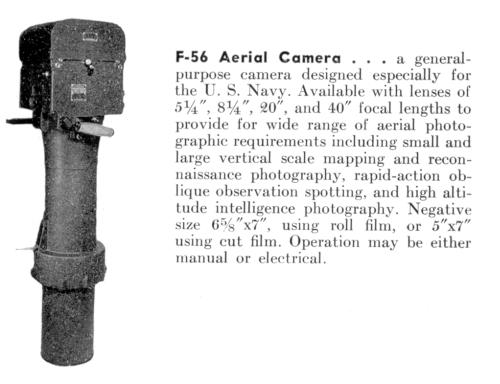
F-56 with 40" lens. Both the 20" and 40" versions used telephoto lenses.
(Telephoto lens designs are generally shorter in physical length than
the focal length.)
___________________________________________________________
Format: 6 5/8" x 7" (roll film)
Lens: 5.25" f.l. - f/6.3 - 64.50° x 67.38° view angle
8.25" f.l. - f/4.0 - 43.75° x 45.98° view angle
20" f.l. - f/5.0 - 18.81° x 19.85° view angle
40" f.l. - f/8.0 - 9.47° x 10.00° view angle
Shutter: Between the lens
1/35, 1/50, 1/100, 1/150 second
Operation: Manual or electrical
Magazine: A-1A - 120 feet - 200 exposures
___________________________________________________________
Miscellaneous Photos 1
Unless otherwise noted, the photographs on this page are from the scrapbook of my father, "Mel" Varney, ball turret gunner on Capt. Wilson's crew.
These photos were all taken between mid-March and mid-December 1944. The squadron was at Nadzab, New Guinea, then Biak Island in this time frame.
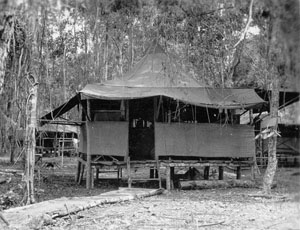 This
is the typical enlisted man's condominium at Nadzab, New Guinea,
March-August 1944. (Officer accommodations were no better.)
Specifically, this was Dad's home-sweet-home which he shared with 3-5
other members of the squadron. The tents did little to protect their
inhabitants from torrential downpours, oppressive heat and humidity, and
insects.
This
is the typical enlisted man's condominium at Nadzab, New Guinea,
March-August 1944. (Officer accommodations were no better.)
Specifically, this was Dad's home-sweet-home which he shared with 3-5
other members of the squadron. The tents did little to protect their
inhabitants from torrential downpours, oppressive heat and humidity, and
insects.
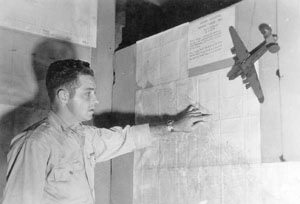 The
squadron commander, Major Joe Davis, makes a point. The sheet of paper
under the right wing tip of the model reads: "Ground Situation,
Madang-Hansa Bay, Activity as of 8 Jun 44. Aussie troops continue to
advance NW along the coast and have reached Cape Gourdon. No contact or
sign of the enemy. Our troops that landed on Karkar Island have
completed a circuit of the island and report no contact."
The
squadron commander, Major Joe Davis, makes a point. The sheet of paper
under the right wing tip of the model reads: "Ground Situation,
Madang-Hansa Bay, Activity as of 8 Jun 44. Aussie troops continue to
advance NW along the coast and have reached Cape Gourdon. No contact or
sign of the enemy. Our troops that landed on Karkar Island have
completed a circuit of the island and report no contact."
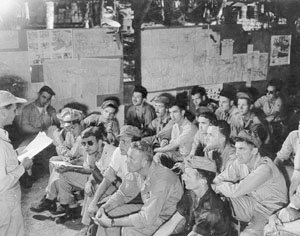 Final
briefing. Three members of Wilson's crew are recognizable: copilot,
Lt. Ben Woodall, (hat-less, hands clasped, arms on knees) sits
attentively in the front row; to his right, left hand on right elbow is
Sgt. Robert Sherr, gunner; Lt. Wilson, pilot and flight leader, sits
against wall, facing the camera (left hand to chin, cap cocked to his
right).
Final
briefing. Three members of Wilson's crew are recognizable: copilot,
Lt. Ben Woodall, (hat-less, hands clasped, arms on knees) sits
attentively in the front row; to his right, left hand on right elbow is
Sgt. Robert Sherr, gunner; Lt. Wilson, pilot and flight leader, sits
against wall, facing the camera (left hand to chin, cap cocked to his
right).
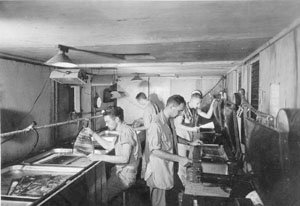 When
the weather was good and the photo missions regular, these photo lab
technicians had plenty to do. The April 1945 Squadron History report
tallies this output for 25 missions flown: 175 rolls of film, 10,192
negatives, 78,996 prints (63,595 of them K-18 9"x18"), and 2400 reprints
of B-29 photographs taken over Tokyo by other squadrons. In one 24-hour
period, three shifts turned out 8,500 prints.
When
the weather was good and the photo missions regular, these photo lab
technicians had plenty to do. The April 1945 Squadron History report
tallies this output for 25 missions flown: 175 rolls of film, 10,192
negatives, 78,996 prints (63,595 of them K-18 9"x18"), and 2400 reprints
of B-29 photographs taken over Tokyo by other squadrons. In one 24-hour
period, three shifts turned out 8,500 prints.
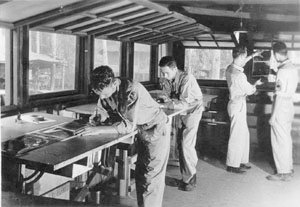 Titling photographs. To see what these draftsmen are up to, see the words at the bottom of the next photo.
Titling photographs. To see what these draftsmen are up to, see the words at the bottom of the next photo.
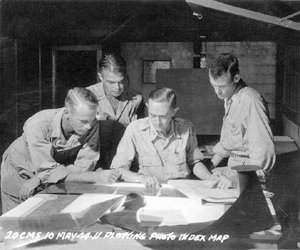 Making
a photo index map--a map of a map. The photo index map outlined on a
composite aerial map all the photos which comprised it. Lt. Woodall,
Wilson's copilot, looks on at left. Note the unspooled film.
Making
a photo index map--a map of a map. The photo index map outlined on a
composite aerial map all the photos which comprised it. Lt. Woodall,
Wilson's copilot, looks on at left. Note the unspooled film.
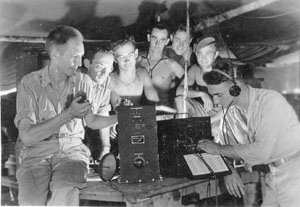 This
was captioned "Radio shack". I have no idea what these chaps were up
to, but it looks like they were having too much fun for it to have been
work.
This
was captioned "Radio shack". I have no idea what these chaps were up
to, but it looks like they were having too much fun for it to have been
work.
The man on the left has his hand on a BC-306-A Antenna Tuner, which is
not connected to anything. The man at right has his headphones plugged
into a BC-221 Frequency Meter.
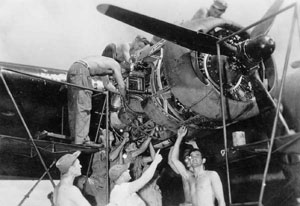 Too many cooks. This Pratt & Whitney Twin Wasp has all the help it can handle.
Too many cooks. This Pratt & Whitney Twin Wasp has all the help it can handle.
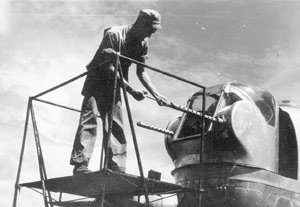 Charlie Heskew, the Wilson crew nose gunner, cleans guns on "T.S."
Charlie Heskew, the Wilson crew nose gunner, cleans guns on "T.S."
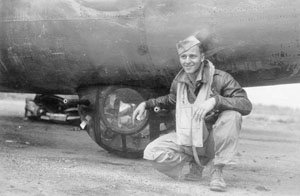 "Mel"
Varney poses with the ball turret, his station aboard "T.S." The
retractable Sperry A-13 turret has been lowered and rotated for this
photo.
"Mel"
Varney poses with the ball turret, his station aboard "T.S." The
retractable Sperry A-13 turret has been lowered and rotated for this
photo.
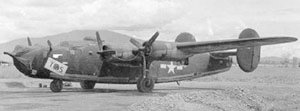 This
is F-7A 42-64051 not too long after it arrived at Nadzab in March 1944.
"T.S." and crew were the first of the air echelon to arrive overseas
from stateside. The paint is the camouflage employed for AAF photo
planes until mid-1944: dark blue topside, lighter blue under. The white
marks above the nose art are the handiwork of the Army censor. What he
obliterated would have read something like: U.S. ARMY B-24J-1-CF, AAF
SERIAL NO. 42-64051 F-7A.
This
is F-7A 42-64051 not too long after it arrived at Nadzab in March 1944.
"T.S." and crew were the first of the air echelon to arrive overseas
from stateside. The paint is the camouflage employed for AAF photo
planes until mid-1944: dark blue topside, lighter blue under. The white
marks above the nose art are the handiwork of the Army censor. What he
obliterated would have read something like: U.S. ARMY B-24J-1-CF, AAF
SERIAL NO. 42-64051 F-7A.
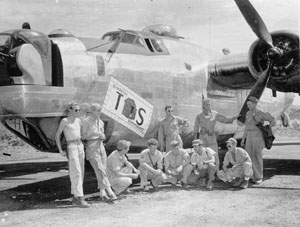 By
early June 1944 when this crew photo was taken, all the camouflage
paint had been stripped from "T.S." In the photo, left-to-right,
standing are: ____ , T/Sgt. Gray - engineer, Sgt. Varney - ball turret
gunner, Lt. Woodall - copilot, S/Sgt. Kujawski - radio operator
By
early June 1944 when this crew photo was taken, all the camouflage
paint had been stripped from "T.S." In the photo, left-to-right,
standing are: ____ , T/Sgt. Gray - engineer, Sgt. Varney - ball turret
gunner, Lt. Woodall - copilot, S/Sgt. Kujawski - radio operator
Left-to-right, kneeling: Lt. Wilson - pilot, S/Sgt. Hagel -
photographer, ____ , Sgt. Sherr - gunner, and Sgt. Heskew - nose gunner.
The nose art is a "Tough Sh.." card with an outhouse in the center. The boxes around the perimeter of a T.S. card could be X'd out, or punched ticket fashion, to indicate use. In this one the card bearer had a choice of receiving sympathy or remembrance. For "T.S.", the boxes were "punched" by painting mission marker symbols in them.
The nose art was applied at Hickam Field, Hawaii while the repair of
leaking fuel tanks delayed the trip to New Guinea--all much to the
crew's chagrin, I'm sure.
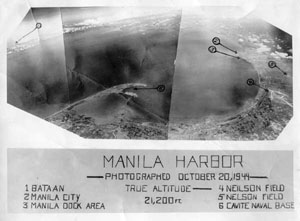 This is a mosaic of three successive exposures by the same oblique
camera (K-17 with 6" lens). From Manila Bay geography, the aircraft
was along a SW-NE line of flight and SE of Bacoor Bay when this sequence
was made. (Arrow (6.) points to Canacao Bay. The larger bay SW of it
is Bacoor Bay.) From camera geometry, at 21,200 feet either oblique
camera would take in a distance along the earth surface of 1.7 to 178
statute miles from directly below. This gives a photo scale in a
single exposure that covers a huge 40.8 : 1 range (1:46,110 to
1:1,883,300). See next image.
This is a mosaic of three successive exposures by the same oblique
camera (K-17 with 6" lens). From Manila Bay geography, the aircraft
was along a SW-NE line of flight and SE of Bacoor Bay when this sequence
was made. (Arrow (6.) points to Canacao Bay. The larger bay SW of it
is Bacoor Bay.) From camera geometry, at 21,200 feet either oblique
camera would take in a distance along the earth surface of 1.7 to 178
statute miles from directly below. This gives a photo scale in a
single exposure that covers a huge 40.8 : 1 range (1:46,110 to
1:1,883,300). See next image.
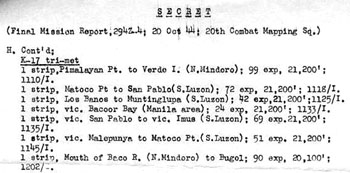 (Goes with photo above) From the last page of Final Mission Report
294Z-4 flown 20 Oct 44 by F-7B's 44-40199 and 44-40847 in what was the
deepest penetration of the Philippines by the Fifth Air Force to that
date. The report entry for the fourth strip of K-17 tri-met
photography (vic. of Bacoor Bay) describes the run which produced the
photo above. The 24 exposures would have been eight shots of the three
cameras fired simultaneously, and time-spaced to give a 55-60% overlap
along the flight line for stereoscopic analysis. The entry "1133 / I"
indicates the time in zone "I", which is Greenwich Mean Time plus 9
hours.
(Goes with photo above) From the last page of Final Mission Report
294Z-4 flown 20 Oct 44 by F-7B's 44-40199 and 44-40847 in what was the
deepest penetration of the Philippines by the Fifth Air Force to that
date. The report entry for the fourth strip of K-17 tri-met
photography (vic. of Bacoor Bay) describes the run which produced the
photo above. The 24 exposures would have been eight shots of the three
cameras fired simultaneously, and time-spaced to give a 55-60% overlap
along the flight line for stereoscopic analysis. The entry "1133 / I"
indicates the time in zone "I", which is Greenwich Mean Time plus 9
hours.
Miscellaneous Photos 2
Unless otherwise noted, the photographs on this page are from the scrapbook of my father, "Mel" Varney, ball turret gunner on Capt. Wilson's crew.
These crew photos are from those on the roster in the early months overseas. The 12 crews on the roster at the end of April 1944 (the first month of combat operations) were those of these pilots: Barstow, Brower, Ecoff, Erickson, Harms, Hunt, Noble, Rives, Roberts, Somerville, Wooten, and Wilson. By the end of June 1944, Barstow's crew had been lost and was replaced by Olsen's. In July four more crews were added (Clover's, Davis', McClay's, and Toye's), bringing the total to 16. By the end of January 1945 the number of aircrews had risen to 26, and hovered in the low 20's until the end of the war.
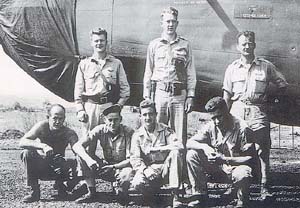 Barstow's crew
Barstow's crew
Standing, L-R: Lt. Jack S. Connor - copilot,
Lt. Victor L. Rushfeldt - navigator,
Lt. Loren G. Barstow - pilot
Photo courtesy of Margaret Elliott - from the scrapbook of her
stepfather, William J. Anderson, 20th CMS aerial photographer-gunner
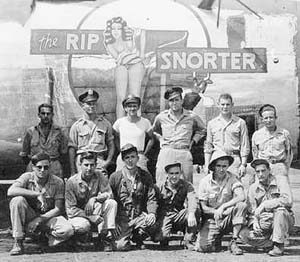 Brower's crew with F-7A "The Rip Snorter", camouflage paint partially removed
Brower's crew with F-7A "The Rip Snorter", camouflage paint partially removed
Standing, L-R: Sgt. Leonard Hein - tail gunner, Lt. Otis McClure -
copilot, Lt. Leroy Peterson - navigator, Lt. Ralph Brower - pilot,
S/Sgt. Challen Wells - photographer, Bruno Mallett - crew chief
Kneeling, L-R: Sgt. Bernard - gunner, Sgt. Fred Brendel - gunner,
S/Sgt. E. Burkhardt - radio operator, Sgt. E. C. Beard - gunner, Sgt.
Ralph Aikin - engineer, Sgt. Isaac M. Miller - gunner
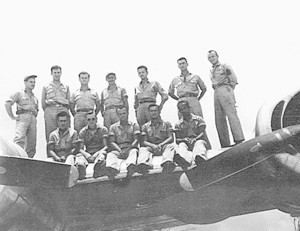 Davis'/Adams' crew
Davis'/Adams' crew
Standing, L-R: Maj. Joseph Davis - pilot (Sqdn. Cmdr.), Capt.
James Adams - pilot, Lt. Fenton Garner - copilot, T/Sgt. Hugh Reynolds -
engineer, M/Sgt. William Anderson - photographer, T/Sgt. Donald Urie -
radio operator,
Seated, L-R: Sgt. Arthur Liss - gunner, Sgt. Harry Erickson -
gunner, Sgt. Jack Hartman - gunner, Sgt. Alcale Bernard - gunner, Sgt.
Floyd Sims - gunner
Photo courtesy of Margaret Elliott - from a 1944 Christmas card sent home by her stepfather, William J. Anderson
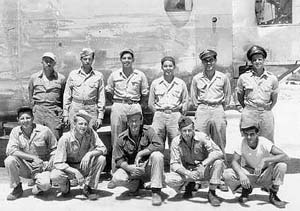 Ecoff's crew
Ecoff's crew
Standing, L-R: S/Sgt. James Welch - photographer, S/Sgt. George
Dilkes - radio operator, T/Sgt. James Duffy - engineer, Lt. Warren
Riopelle - navigator, Lt. Lawrence Thibault - copilot, Lt. David W.
Ecoff - pilot
Kneeling, L-R: Cpl. Jay H. Smith - tail turret gunner, Sgt. Ray
Carlson - waist gunner, Sgt. David Thomas - ball turret gunner, Sgt.
Robert Bailey - nose turret gunner, Sgt. Gerald Kells - waist gunner
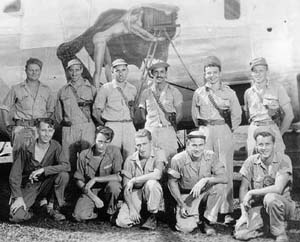 Harms' crew with F-7A "Photo Queen", nose art incomplete
Harms' crew with F-7A "Photo Queen", nose art incomplete
Standing, L-R: T/Sgt. Stephen H. Laichak - engineer, Sgt. Herbert
G. Julian - gunner, S/Sgt. Melvin J. West - photographer, 2nd Lt.
Thomas Rafael - copilot, 1st Lt. Royce E. Harms - pilot
Kneeling, L-R: Sgt. Black - gunner, Sgt. Boyd D. Berg - gunner,
T/Sgt. James R. Reynolds - radio operator, Sgt. Samuel T. Catlin -
gunner, Sgt. Harold E. Amos - gunner. All in this photo except Sgt.
Black were lost on a mission, 30 September 1944
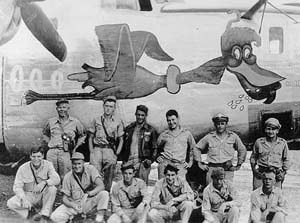 Hunt's crew with F-7A "The Wango Wango Bird", nose art incomplete
Hunt's crew with F-7A "The Wango Wango Bird", nose art incomplete
Standing, L-R: Sgt. Cecil Pearson - gunner, Sgt. Ernest Rushing -
engineer, M/Sgt. Judy - flight chief, Lt. Simms - navigator, 2nd Lt.
Barry C. Conway - copilot, 1st Lt. Roy A. Hunt - pilot
Kneeling, L-R: S/Sgt. William S. Willison - photographer, Sgt.
Smith, Sgt. Russell McSparin - gunner, Sgt. James F. Whitmore - gunner,
Sgt. J.J. Jarman - gunner, S/Sgt. Lawrence J. Winkle - radio operator.
Seven of the crew pictured here were lost in a landing accident, 9 June 1944.
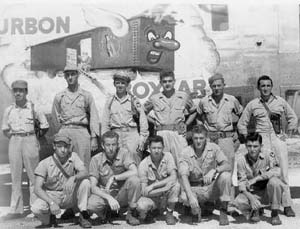 Noble's crew with F-7A "Bourbon Boxcar"
Noble's crew with F-7A "Bourbon Boxcar"
Standing, L-R: Lt. (later Capt.) John Noble - pilot, Lt. Joseph
McMillen - copilot, Lt. Charles Nutting - navigator, S/Sgt. Edwin
Anderson - photographer
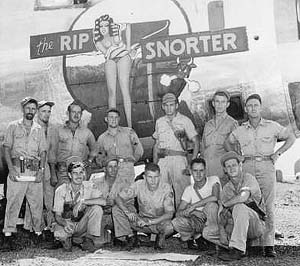 Olsen's crew with F-7A "The Rip Snorter"
Olsen's crew with F-7A "The Rip Snorter"
Standing, L-R: S/Sgt. Steven Peer - photographer, S/Sgt. E. P.
Stevens - waist gunner, ____ - mechanic, S/Sgt Al Deans - waist gunner,
T/Sgt. Wayne O'Neal - engineer, S/Sgt. Stanley Bokelmann - radio
operator, Lt. Ted Olsen - pilot
Kneeling, L-R: Lt. Elroy Bohlin - copilot, Sgt. Thompson -
gunner, Sgt. Dean Schiefelbein - nose gunner, Sgt. Donald Myhill - ball
turret gunner, Lt. John Boyd - navigator
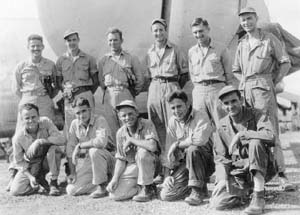 Roberts' crew
Roberts' crew
Standing, L-R: Capt. John D. Roberts - pilot, Lt. Harry R. Chisek - copilot, Lt. H. Nichols - navigator
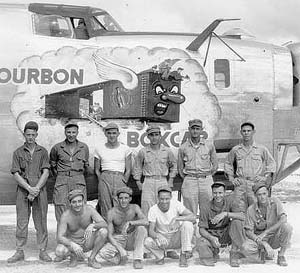 Wilson's crew with F-7A "Bourbon Boxcar". With no cameras installed one can see through the fuselage
Wilson's crew with F-7A "Bourbon Boxcar". With no cameras installed one can see through the fuselage
Standing, L-R: S/Sgt. George L. Hagel - photographer, S/Sgt.
Frank M. Kujawski - radio operator, T/Sgt. Francis M. Gray - engineer,
1st Lt. Fred T. Simpson - navigator, Maj Deems (91st Photo Wing) -
copilot, Capt. William A. Wilson, Jr. - pilot
Kneeling, L-R: Sgt. Robert Sherr - gunner, S/Sgt. Russell
McSparin - gunner, Sgt. Burt D. McCorquodale - gunner, Sgt. Charles M.
Varney - ball turret gunner, S/Sgt. Charles E. Heskew - nose turret
gunner
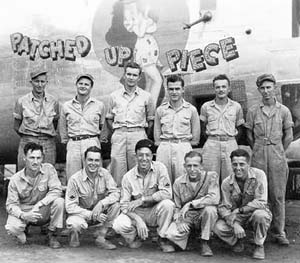 Wooten's crew with F-7A "Patched Up Piece"
Wooten's crew with F-7A "Patched Up Piece"
Standing, L-R: ____ , ____ , Lt. Jay Robbins - navigator, Lt.
Lawrence E. Thibault - copilot, Lt. John Wooten - pilot, S/Sgt. Kristien
Brisied - engineer
Kneeling, L-R: Sgt. Anthony Currelle - gunner, S/Sgt. Joseph
Lamberti - photographer, S/Sgt. Stephen Distasio - radio operator, ____ ,
____
Miscellaneous Photos 3
The images on this page are from material contributed by David W. Ecoff, Sr. Dave is the 20th Combat Mapping Squadron reunion coordinator, Hawkeyes Newsletter Editor, and all-around focal point for matters relating to the 20th.
Dave was one of the original 12 F-7A pilots to arrive overseas in the spring of 1944. He retired in 1980 as a Lt. Colonel in the Air Force Reserve, having long before traded in his B-24 derivatives for KC-97's.
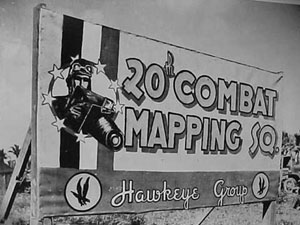 This
version of 20th CMS signboard was probably photographed at Biak Island
in the fall of 1944. (Compare it to the earlier sign which appears at top
of the home page.)
This
version of 20th CMS signboard was probably photographed at Biak Island
in the fall of 1944. (Compare it to the earlier sign which appears at top
of the home page.)
The "Hawkeyes" Group at the time was the 6th Photographic Group,
Reconnaissance and included, besides the 20th CMS: the 8th, 25th, and
26th Photographic Reconnaissance Squadrons, all flying F-5's (photo
versions of P-38 Lightnings). In late 1944 a fourth F-5 squadron was
added: the 36th.
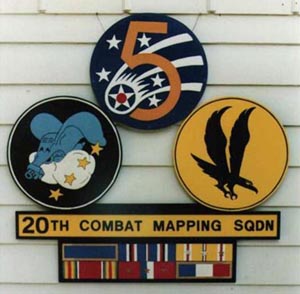 Patches and ribbons relating to the 20th Combat Mapping Squadron / 20th Reconnaissance Squadron, Long Range, Photo-RCM.
Patches and ribbons relating to the 20th Combat Mapping Squadron / 20th Reconnaissance Squadron, Long Range, Photo-RCM.
The three patches are left-to-right: (1) the squadron, "Flying Dumbos", with the four stars representing the 4th Photographic Group, to which the 20th belonged before going overseas; (2) the Fifth Air Force patch; and (3) the group symbol of the 6th Photo Group "Hawkeyes"--a diving black hawk--on a background of the 20th's squadron color, yellow.
The ribbons represent the squadron's World War II service. They are, left-to-right, top-to-bottom: Distinguished Unit Citation for 18-25 Sep 44 photo work preparatory to the invasion of Leyte; the American Theater service streamer; the Pacific-Asiatic Theater Medal with 11 service stars; the World War II Victory Medal; the Philippine Liberation Medal with three service stars; the Philippine Presidential Unit Citation.
(The display was built and photographed by Dave Ecoff. This image
of it was provided by Rich Lacharite, son of 20th veteran, Joseph M.
Lacharite.)
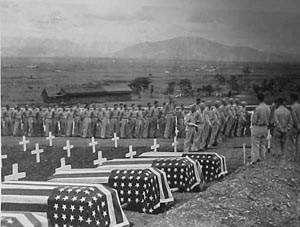 The first overseas loss for the squadron was Lt. Loren Barstow's crew.
In the early morning darkness of 22 May 1944, F-7A 42-73052 crashed
near the peak of Mt. Wilhelm, New Guinea. All aboard perished. The
crew was ultimately recovered and temporarily interred at Nadzab.
The first overseas loss for the squadron was Lt. Loren Barstow's crew.
In the early morning darkness of 22 May 1944, F-7A 42-73052 crashed
near the peak of Mt. Wilhelm, New Guinea. All aboard perished. The
crew was ultimately recovered and temporarily interred at Nadzab.
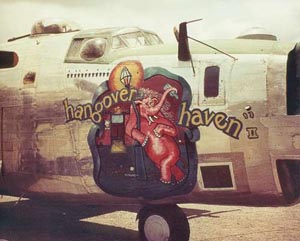 This
is a color example of Al Merkling's art work. The aircraft is F-7A
42-64053, "Hangover Haven II". To the left of the nose art are mission
markers for 11 missions, seven of them successful. The basic mission
symbol was a black aerial camera silhouette, suggestive of a K-17 camera
with 12" lens cone. A five-pointed star was painted above the camera
for a successful mission. There were three defined symbol combinations
for a failed mission: camera with cloud and lightning bolt for failure
due to weather, camera with X for mechanical failure, and camera with C.F.
for crew failure. The only one of these commonly used was the camera
with cloud. Often a failed mission, whatever the reason, was represented
by only a camera.
This
is a color example of Al Merkling's art work. The aircraft is F-7A
42-64053, "Hangover Haven II". To the left of the nose art are mission
markers for 11 missions, seven of them successful. The basic mission
symbol was a black aerial camera silhouette, suggestive of a K-17 camera
with 12" lens cone. A five-pointed star was painted above the camera
for a successful mission. There were three defined symbol combinations
for a failed mission: camera with cloud and lightning bolt for failure
due to weather, camera with X for mechanical failure, and camera with C.F.
for crew failure. The only one of these commonly used was the camera
with cloud. Often a failed mission, whatever the reason, was represented
by only a camera.
Unplanned, Unwanted, Landing at Middleburg Island
On 14 August 1944 the crews of Lts. Brower, Rives, and Ecoff departed Biak for photo mission 227Z-6 to Morotai Island. After arrival at the target, Ecoff's craft, F-7A 42-64047 "Patched Up Piece", lost oil pressure in engine #4, which was eventually shutdown. Ecoff aborted the mission and turned for home, expecting an uneventful 3-engine return. After a slow descent to 10,000 feet on the return, engine #3 followed the example of #4 and it too was shut down. With both starboard engines out, #4047 was more than a handful for both pilot and copilot, so Air-Sea Rescue was notified and a place to park the ailing bird was sought out.
To the crew's good fortune, tiny Middleburg Island had recently been occupied by American forces who were busy building a landing strip there. The navigator, Lt. Warren Riopelle, got them there with still a few thousand feet of altitude in hand. A red flare fired by flight engineer, Jim Duffy, cleared the Corps of Engineers and their equipment from the strip and Ecoff set "Patched Up Piece" down just 15 feet from the end of the runway and stopped her in 1800 feet. All four engines were later found to be dangerously low on oil.
The crew was able to depart on 16 August, after sufficient additional runway had been completed to enable a safe takeoff. (A navigation map dating from the period shows the runway was eventually 5400 feet long--virtually the entire length of the island.)
The photos below were courtesy of newsreel crews on hand to record the first landing on Middleburg. It was not intended that that honor be afforded a young 20th CMS pilot, but instead it was intended to go to a General who was on hand for the occassion. Needless to say the General was not happy to be upstaged from out of the blue. I suspect he made every effort to get that F-7A off his island, post haste.
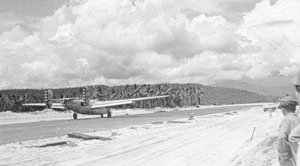 Cameraman on Middleburg catches Dave Ecoff setting down "Patched Up Piece" on 1800 feet of incompleted runway.
Cameraman on Middleburg catches Dave Ecoff setting down "Patched Up Piece" on 1800 feet of incompleted runway.
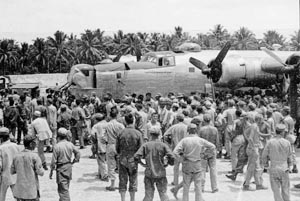 The unexpected arrival of "Patched Up Piece" draws a crowd. Out of camera shot construction of the runway continues.
The unexpected arrival of "Patched Up Piece" draws a crowd. Out of camera shot construction of the runway continues.
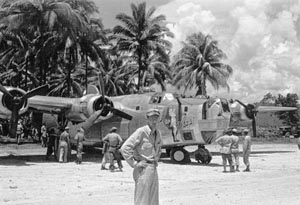 The
crew waited nearly three days for enough runway to be completed for a
safe takeoff and return to Biak. In the interim #4047 was the biggest
show in town.
The
crew waited nearly three days for enough runway to be completed for a
safe takeoff and return to Biak. In the interim #4047 was the biggest
show in town.
F-7B Crew Accepts Surrender of Japanese Airbase
On 6 September 1945, four days after the Japanese unconditional surrender, the crews of Lt. Chuck Bridge and Lt. John Bock were over Honshu engaged in a photo mission. Their primary interest was a fighter base where about 60 war-weary aircraft were assigned. Bock's aircraft, F-7B 44-42028, developed an engine problem which required it to be shut down. The loss was made worse by props that wouldn't feather, so Bock started back for his base at Okinawa. Soon thereafter a second engine failure followed the first. A 900-mile trip home on two engines was judged more than risky so he elected to return to his photo target and land. Beyond alarming the inhabitants, the landing was uneventful until the craft turned onto a taxiway and its right main wheel went through the concrete. Bridge landed after Bock to offer assistance. He stayed on the runway.
The intruders were met by the base commander who offered his sword in a gesture of surrender, having anticipated a full scale invasion. (The war was over, but no occupation troops had yet landed in the area.) Some uneasy first moments passed, communication was established, and things settled down. Having assured the safety of Bock's crew, and after removal of a few sensitive devices (e.g., Norden bombsight), Bridge departed the fighter strip for Okinawa with a rather spectacular short takeoff run.
The Japanese brought Bock's crew food, chairs, a wind-up phonograph, and Bing Crosby records to ease the stay.
All efforts to extricate the trapped aircraft failed, so it was decided to leave it--but not in one piece. After a few days a Navy PBY Catalina, escorted by eight P-38's, arrived to pick up the crew. The primary task of the P-38's was to strafe the stranded F-7B into oblivion, which they did to great effect.
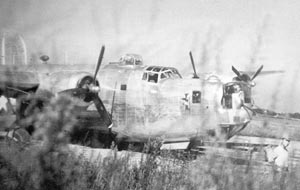 F-7B
44-42028 with Japanese guard. (Guards were posted to protect the
aircraft from the local citizenry who were less than happy to have an
instrument of their former enemy on the ground nearby.) Note the depth
to which the right main has penetrated the taxiway.
F-7B
44-42028 with Japanese guard. (Guards were posted to protect the
aircraft from the local citizenry who were less than happy to have an
instrument of their former enemy on the ground nearby.) Note the depth
to which the right main has penetrated the taxiway.
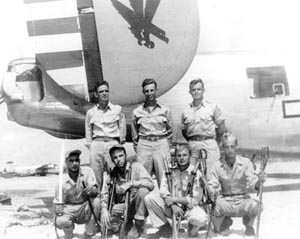 Members of the crew pose with souvenirs after their return to Okinawa.
Members of the crew pose with souvenirs after their return to Okinawa.
Standing, left-to-right: Lt. Porter Walton - navigator, Lt. John Bock - pilot, Lt. James Hurley - copilot.
Kneeling, left-to-right: S/Sgt L.J. Pellerin, Sgt. Ned Alexander, Sgt. Larry Hilgart, Sgt. F. Teeman, Jr.
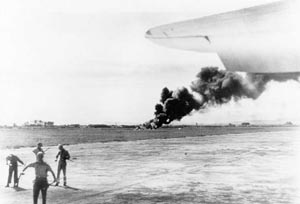 After strafing by eight P-38's, smoke rolls up from the once-proud F-7B.
After strafing by eight P-38's, smoke rolls up from the once-proud F-7B.
Distinguished Flying Cross Awarded 55 Years Late
On 24 October 1944 Lt. Dave Ecoff in F-7B 44-40199, Lt. John Wooten in F-7B 44-40961, and Lt. Richard Tubbs in F-7B 44-40602, staged from Morotai on Mission 298Z-3 to southern Luzon. South of Mindoro, Wooten and Ecoff's crews sighted a Japanese naval task force apparently enroute to Leyte. Upon reaching the target, cloud cover prevented the assigned mission, so the pair turned south for home. On the return more naval ships were sighted, this time west of Negros. Risking anti-aircraft fire the two F-7B's dropped down below clouds and photographed the task force.
Lt. Wooten's crew was ultimately awarded the Distinguished Flying Cross (DFC) for the mission, but Dave Ecoff's was not. Decades later a casual conversation at an Experimental Aircraft Association fly-in eventually changed that. Dave Ecoff and Paul DiMascio met at the 1991 Oshkosh fly-in, the two brought together by a book of World War II nose art Paul had just purchased. Paul and his wife, Donna, struck up a friendship with Dave which led to Donna's building Dave's war time letters into a book--and then campaigning to get the DFC for Dave and his crew.
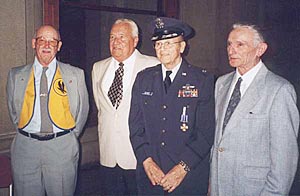 Donna
succeeds! With the aid of New York Congressman Gerald Solomon, and by
her own perseverance, Donna got Dave Ecoff his DFC. This photo was taken
on 18 June 1999 after the DFC award ceremony in Albany, New York.
Veterans of the 20th Combat Mapping Squadron in attendance were,
left-to-right: Roy Bailey, Ed Brown, the honored guest, and Jack
Baldassare. (Chuck Varney photo)
Donna
succeeds! With the aid of New York Congressman Gerald Solomon, and by
her own perseverance, Donna got Dave Ecoff his DFC. This photo was taken
on 18 June 1999 after the DFC award ceremony in Albany, New York.
Veterans of the 20th Combat Mapping Squadron in attendance were,
left-to-right: Roy Bailey, Ed Brown, the honored guest, and Jack
Baldassare. (Chuck Varney photo)
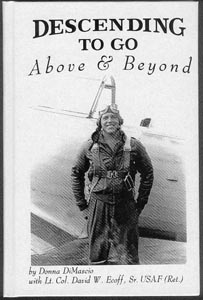 Donna
DiMascio chronicled her pursuit of the DFC in the appendices of
"Descending to Go Above & Beyond", the book she authored based on
Dave Ecoff's war time letters home.
Donna
DiMascio chronicled her pursuit of the DFC in the appendices of
"Descending to Go Above & Beyond", the book she authored based on
Dave Ecoff's war time letters home.
Miscellaneous Photos 4
The four images that follow are from the scrapbook of James Codd, 20th Combat Mapping Squadron photo lab technician.
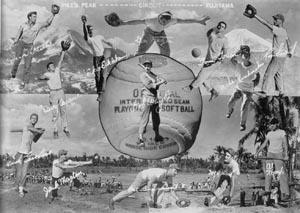 Softball - Pikes Peak to Fujiyama. From Colorado to Japan, the 20th's softball teams were among the best.
Softball - Pikes Peak to Fujiyama. From Colorado to Japan, the 20th's softball teams were among the best.
 The
U.S.S. Westpoint (AP-23) in camouflage paint. This ship carried the
ground echelon from Camp Stoneman, California to Sydney, Australia in
the fall of 1943. None who experienced it have forgotten the 15-day
transit, stuffed into H Deck, 40 feet below the waterline.
The
U.S.S. Westpoint (AP-23) in camouflage paint. This ship carried the
ground echelon from Camp Stoneman, California to Sydney, Australia in
the fall of 1943. None who experienced it have forgotten the 15-day
transit, stuffed into H Deck, 40 feet below the waterline.
The Westpoint itself has an interesting history. It was launched at Newport News Shipbuilding & Drydock Co. in August 1939 as the cruise ship S.S. America. At 723 feet overall length and 34,000 tons displacement, it was the largest merchant ship built in the United States. Designed to carry 1200-1500 passengers at a cruise speed of 22 knots, it was pressed into war service and converted to a troop ship in mid-1941. It carried more than 400,000 troops in Atlantic and Pacific ocean crossings by the end of the war. In one notable Atlantic crossing it carried 9,000 (miserable, to be sure) troops.
After the war it was returned to cruise service and operated until 1980.
In 1994, while under tow in the Canary Islands, the tow rope broke,
the ship grounded and broke up. Its hulk lies there still.
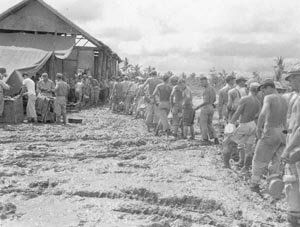 Chow line, Dulag (Julita), Leyte.
Chow line, Dulag (Julita), Leyte.
There is universal agreement that Leyte was the muddiest place the squadron was stationed.
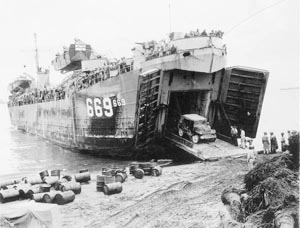 LST-669 lands the squadron at Okinawa.
LST-669 lands the squadron at Okinawa.
LST-669 was launched by the American Bridge Co. in May 1944. It was 327
feet long, displaced 4,000 tons fully loaded, "cruised" at 9 knots, and
topped out at just under 11 knots.
The next photos are from the collection of Joseph Lacharite, 20th CMS/RS aerial photographer, and were provided by his son, Rich Lacharite
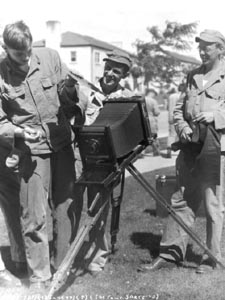 Lowry Field was the training base for Army Air Force photographers.
Lowry Field was the training base for Army Air Force photographers.
They learned to use an 8x10 view camera first.
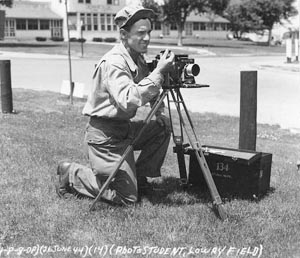 Joe Lacharite as student at Lowry.
Joe Lacharite as student at Lowry.
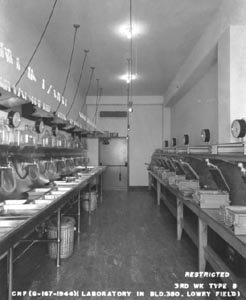 Photo lab at Lowry. It was never like this overseas!
Photo lab at Lowry. It was never like this overseas!
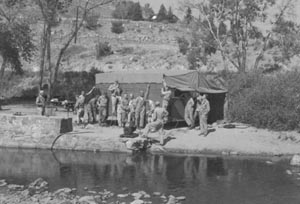 Photo class roughing it--at least for Lowry. Trailer is an A-2 portable photo lab.
Photo class roughing it--at least for Lowry. Trailer is an A-2 portable photo lab.
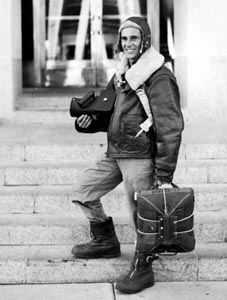 Joe Lacharite at Lowry --dressed for flying. Looks like a K-20 hand held camera.
Joe Lacharite at Lowry --dressed for flying. Looks like a K-20 hand held camera.
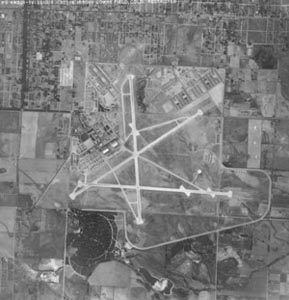 Aerial photo of Lowry Field and surrounds.
Aerial photo of Lowry Field and surrounds.
This photo is from Frank Pallone, 20th gunner, via his nephew, Jerry Viracola.
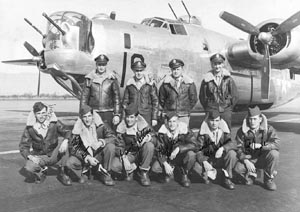 Essig's
crew poses with B-24 #19 at Davis-Monthan AAB, Tuscon, AZ, late 1944.
In mid-December 1944, rather than going overseas as a bomber crew, they
were instead ordered to report to Oklahoma City, Oklahoma on Christmas
Day for reconnaissance crew training. They joined the 20th CMS overseas
about May 1945.
Essig's
crew poses with B-24 #19 at Davis-Monthan AAB, Tuscon, AZ, late 1944.
In mid-December 1944, rather than going overseas as a bomber crew, they
were instead ordered to report to Oklahoma City, Oklahoma on Christmas
Day for reconnaissance crew training. They joined the 20th CMS overseas
about May 1945.
Standing, L-R: Robert W. Essig - pilot, John R. Ziegler - copilot, Kurt F. Rupke - navigator, H. Albaugh - bombardier(?)
Kneeling, L-R: James C. Cook - engineer, R. Nudo - gunner, Frank J.
Pallone - gunner, Raymond E. Zech - gunner, Anthony J. Marchione -
gunner, Edwin "Ted" Angle - radio operator
Twenty nine veterans of the 20th were able to make it to a final squadron reunion, held September 6-8, 2001 in Las Vegas, Nevada.
(Tripp Rives photo, September 2001)
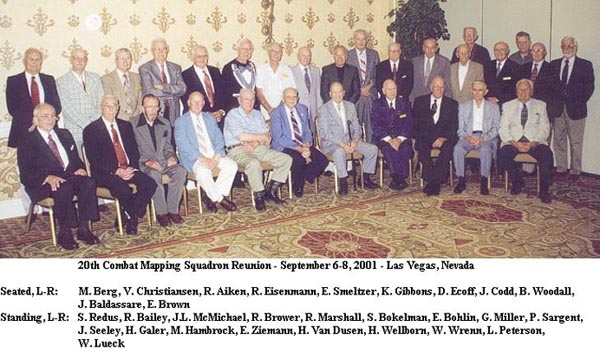
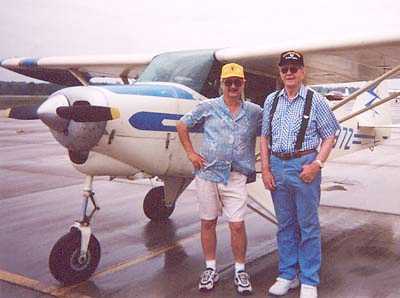 Mike
Velemirov, left, meets his father's pilot, Bob Toye. Between August
1944 and March 1945, Mike's dad, Dan Velemirov, flew 43 missions as Lt.
Toye's nose gunner. Fifty-seven years later Mike and Bob Toye shared
some stick time together over Iowa. Mike, en-route to the 2002 Oshkosh
fly-in detoured to Ankeny Regional Airport north of Des Moines to link
up with Bob. (Mike's plane is a 1961 Piper Colt.)
Mike
Velemirov, left, meets his father's pilot, Bob Toye. Between August
1944 and March 1945, Mike's dad, Dan Velemirov, flew 43 missions as Lt.
Toye's nose gunner. Fifty-seven years later Mike and Bob Toye shared
some stick time together over Iowa. Mike, en-route to the 2002 Oshkosh
fly-in detoured to Ankeny Regional Airport north of Des Moines to link
up with Bob. (Mike's plane is a 1961 Piper Colt.)
Mike Velemirov photo, July 2002
Memoriam
IN MEMORY OF 62 AIR CREW MEMBERS OF THE 20TH WHO DIDN'T RETURN
4 December 1943
F-7 42-40494, on a night cross-country flight to Reading, Pennsylvania,
crashed near Elverson, Pennsylvania. Sgt. John F. Gillespie, AM gunner,
was thrown clear and survived.
- 2nd Lt. George W. Wimsatt, pilot
- 2nd Lt. Allan B. Hamilton, copilot
- 2nd Lt. Martin Queenth, navigator
- T/Sgt. Walter G. Kellbach, crew chief
- T/Sgt. Rufus Mobley, engineer
- S/Sgt. Vincent B. McNally, AM gunner
- S/Sgt. Joseph R. Guay, radio operator
- Sgt. Robert E. Hawkins, gunner
- Sgt. Vern A. Vandelin, gunner
- 2nd Lt. George E. O'Brien, passenger on leave
29 March 1944
Reserve aircraft F-7A 42-64056, ferried by an Air Transport Command
(ATC) crew, crashed into the Pacific an hour after departing
Fairfield-Suisun, California for Hickam Field, Hawaii en route to New
Guinea. Two members of the squadron--Sgt. Joseph J. Kuchinski, sheet
metal worker, and 1st Lt. Willard F. Tidyman, assistant lab
commander--parachuted to safety. There were no other survivors.
Four (4) unidentified ATC personnel
Four (4) 20th CMS ground personnel:
- Sgt. Jack B. Bierman, draftsman
- Sgt. Arnold I. Bernstein, administrative NCO
- Sgt. Warren V. Burns, draftsman
- S/Sgt. Guy C. Turner, photo lab technician
22 May 1944
F-7A 42-73052 crashed near the peak of Mt. Wilhelm, New Guinea, in early
morning darkness. It was en-route to a mission over Padaidori Island.
There were no survivors.
- 1st Lt. Loren G. Barstow, pilot
- 2nd Lt. Jack S. Connor, copilot
- 2nd Lt. Douglas E. Puck, navigator
- S/Sgt. Harold M. Valentine, radio operator
- S/Sgt. Edwin R. Maille, engineer
- S/Sgt. Leonard Diamond, photographer
- Sgt. John W. Schmitt, gunner
- Sgt. George M. Harvey, gunner
- Sgt. Stephen J. Boudreaux, gunner
- S/Sgt. Luis Degallado, gunner
- S/Sgt. George Dick, gunner
9 June 1944
F-7A 42-73044 blew the right tire landing at Saidor, New Guinea. This
crew was one of three scheduled to stage from Saidor the next day for a
mission to the Geelvink Bay area.
Two crew members survived.
- 1st Lt. Roy A. Hunt, pilot
- 2nd Lt. Barry C. Conway, copilot
- Sgt. Ernest Rushing, engineer
- S/Sgt. William S. Willison, photographer
- S/Sgt. Lawrence J. Winkel, radio operator
- S/Sgt. Cecil Pearson, gunner
- Sgt. James F. Whitmore, gunner
- S/Sgt. Francis J. Reilly, gunner
30 September 1944
F-7B 44-40422 lost returning from mission 274Z-3 to Leyte, Philippine Islands.
- 1st Lt. Royce E. Harms, pilot
- 2nd Lt. Thomas Rafael, copilot
- 1st Lt. Gerald P. Smith, navigator
- T/Sgt. Stephen H. Laichak, engineer
- T/Sgt. James R. Reynolds, Jr., radio operator
- S/Sgt. Melvin J. West, photographer
- Sgt. Harold E. Amos, gunner
- Sgt. Herbert G. Julian, gunner
- Sgt. Boyd D. Berg, gunner
- Sgt. Samuel T. Catlin, gunner
- Sgt. Raymond T. Weld, gunner
11 January 1945
F-7B 44-40961 lost returning from mission 11D-3 to Southeast Luzon.
- 2nd Lt. Francis N. Riley, pilot
- 2nd Lt. Charles E. Steinsberger, copilot
- 2nd Lt. Howard (NMI) Flagg, Jr., navigator
- S/Sgt. Ralph O. Schadewald, engineer
- S/Sgt. Casimir W. Szczawinski, radio operator
- Cpl. Clement A. McHale, photographer
- Sgt. James A. Seeley, gunner
- Sgt. William S. Sheyon, gunner
- Sgt. Joseph F. Phillips, gunner
- Sgt. Marvin H. Normington, gunner
- T/Sgt. Julian C. Langdon, gunner
29 January 1945
A C-46 taking off from Tacloban, Letye crashed into F-7B 44-40659 and
another C-46 parked along side it. The three aircraft exploded.
- 2nd Lt. Richard I. Tubbs, pilot
- 2nd Lt. Paul J. Vivian, copilot
- T/Sgt. Leland L. Lane, engineer
25 May 1945
F-7A 42-73047, destroyed landing at Boroke Strip, Biak.
- 2nd Lt. John D. Pelham, copilot
18 August 1945
While flying aboard a B-32 (42-108578) of the 312th Bomb Group, 386th
Bomb Squadron, Sgt. Anthony J. Marchione was killed over Honshu in an
attack by Japanese fighter aircraft. The attack occurred three days
after the Japanese had declared their intention for peace.
- Sgt. Anthony J. Marchione, aerial gunner
28 August 1945
Two former members of the 20th (September 1944-May 1945) were killed in a
takeoff accident at Yontan Airstrip, Okinawa. B-32 42-108544 of the
312th Bomb Group, 386th Bomb Squadron, skidded off the runway while
trying to abort a takeoff. All 13 aboard perished.
- 1st Lt. Glen W. Bowie, copilot
- 1st Lt. William P. Colley, navigator
6th Photographic Group
General
The 20th was only one of five squadrons that eventually comprised the 6th Photographic Group, Reconnaissance (later Reconnaissance Group). The other squadrons all flew photo reconnaissance versions of the twin-engined P-38 Lockheed Lightning. These squadrons were the 8th, 25th, 26th, and 36th Photographic Reconnaissance Squadrons (later Reconnaissance Squadrons).
The 8th PRS "Eightballers" arrived in the SWPA with F-4's in April 1942--18 months before the 6th Photo Group. The 25th PRS and 26th PRS reached Australia from the States in November 1943. The 20th CMS air echelon arrived at Nadzab, New Guinea in March and April 1944, the ground echelon having arrived in theater in September 1943. The 36th PRS joined the group in December 1944.
Five squadrons in today's Air Force trace their lineage to 6th Photo Group squadrons. They are:
- 8th Flying Training Squadron at Vance AFB, Oklahoma (8th PRS descendent)
- 20th Intelligence Squadron at Offut AFB, Nebraska (20th CMS descendent)
- 25th Flying Training Squadron at Vance AFB, Oklahoma (25th PRS descendent)
- 26th Air & Space Intelligence Squadron at Hickam AFB, Hawaii. (26th PRS descendent)
- 36th Intelligence Squadron at Langley AFB, Virginia (36th PRS descendent)
This is notable, as every squadron that was subordinate to the 6th during World War II has been deemed worthy of rebirth in the Air Force of today.
Group Lineage
- Constituted as 6th Photographic Group, 5 Feb 1943. Activated 9 Feb 1943
- Redesignated 6th Photographic Reconnaissance and Mapping Group, May 1943
- Redesignated 6th Photographic Group, Reconnaissance, Aug 1943
- Redesignated 6th Reconnaissance Group, May 1945
- Disbanded, 6 Mar 1947
Squadrons
- 8th PRS (F-5/P-38): 1943-1946
- 20th CMS/RS (F-7/B-24): 1943-1946
- 25th PRS (F-5/P-38): 1943-1946
- 26th PRS (F-5/P-38): 1943-1945
- 36th PRS (F-5/P-38): 12/1944-1945
Group Stations
- Colorado Springs, Colo, Feb-7 Sep 1943
- Sydney, Australia, 10 Oct 1943
- Brisbane, Australia, 27 Nov 1943
- Port Moresby, New Guinea, 10 Dec 1943
- Nadzab, New Guinea, 17 Feb 1944
- Biak, Aug 1944
- Leyte, 3 Nov 1944
- Clark Field, Luzon, 1 May 1945
- Okinawa, 31 Jul 1945
- Chofu, Japan, 27 Sep 1945
- Irumagawa, Japan, Jan-27 Apr 1946
Group Campaigns
- Air Offensive, Japan
- China Defensive
- New Guinea
- Bismarck Archipelago
- Western Pacific
- Leyte
- Luzon
- Ryukyus
- Southern Philippines
- China Offensive
Group Decorations
- Distinguished Unit Citation: Philippine Islands, 18-25 Sep 1944
- Philippine Presidential Unit Citation
Group Commanders
- Lt Col Waymond A Davis, 9 Feb 1943
- Maj Cecil Darnell, 27 Feb 1943
- Col David W Hutchison, 13 Mar 1943
- Lt Col Cecil Darnell, 24 Mar 1943
- Maj Arthur L Post, 24 Jul 1944
- Lt Col Alexander Guerry, c. 1 Sep 1944
- Lt Col Ben K Armstrong Jr, 5 Jan 1945
- Lt Col Joseph Davis Jr, 31 May 1945-unknown
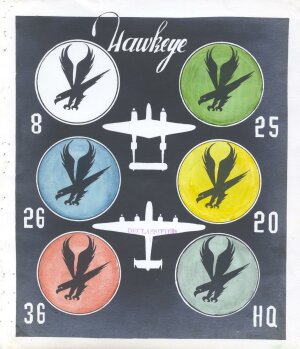 Squadron colors for the 6th Group.
Squadron colors for the 6th Group.
The P-38 silhouette (twin-engined) represents the F-4/F-5 squadrons: the 8th, 25th, 26th, and 36th PRS.
The B-24 silhouette (4-engined) represents the F-7 squadron: the 20th CMS/RS LR-Photo RCM.
(Courtesy of Lt Col Johnson, Commander,
26th Air & Space Intelligence Squadron)
The table below shows stations and dates for the group headquarters and for the squadrons. Unless otherwise noted, the squadron ground and air echelons were co-located.
Source for 6th HQ: Air Force Combat Units of World War II by Maurer Maurer.
Source for squadrons: Combat Squadrons of the Air Force - World War II edited by Maurer Maurer. (20th CMS dates are from squadron history where differences from Maurer exist.)
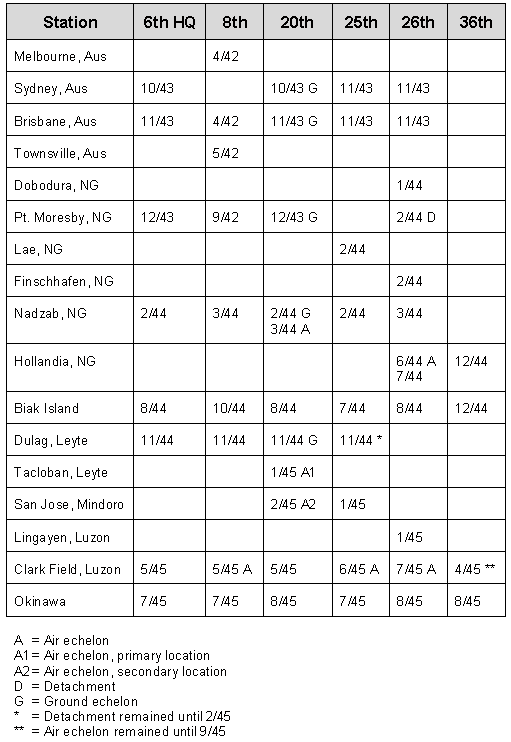
Credits and References
A SPECIAL THANKS TO THOSE WHO GOT ME STARTED WITH THIS
(Sadly, as of March 2, 2014, all of my helpers except Mike Velemirov are now deceased)
Without the patience and generosity of these 20th Combat Mapping Squadron veterans, these pages wouldn't have evolved. Thank you, gentlemen.
- David W. Ecoff, Sr - pilot
- Ben D. Woodall - copilot
- Challen H. Wells - aerial photographer-gunner
Within days, Dave had me linked up with Ben Woodall, copilot on the crew my dad flew with. For a year I feared I'd drive either Dave or Ben, or both, nuts with nearly daily questions. I've marveled at how much they recall and delighted in their willingness to share it.
The lack of e-mail protected Challen Wells from the day-to-day queries, but he graciously accommodated me by mail.
All three men have loaned me their possesions, given me gifts relating to the squadron, and shared their time. I thank you all again.
There are two others to whom I owe a thank you:
Mike Velemirov, a fellow "son of a gunner" (20th CMS gunner, that is) for digging up the Squadron History and Mission Reports in his effort to learn more about what his dad did. These documents provided me the detail of the squadron's activities.
My mother, who lived through the war years as wife and mother of an infant son, and who saved the almost daily letters my father wrote, and dug through them and other memorabilia for me.
REFERENCES
Air Force Historical Research Agency, Squadron History of the 20th Combat Mapping Squadron, microfilm roll 10-213, Maxwell AFB, Alabama
American Photogrammetric Society, Manual of Photogrammetry, American Society of Photogrammetry, Washington, D.C., Second Ed., 1952
Blue, Allan G., The B-24 Liberator: A Pictorial History, Charles Scribner's Sons, New York, 1977
Fairchild Camera and Instrument Co., Focusing on Victory - The Story of Aerial Photography at War, Jamaica, NY, 1944
Greenleaf, Allen R., Photographic Optics, The MacMillan Company, New York, 1950
Kingslake, Rudolf, Ed., Applied Optics and Optical Engineering, Vol IV, Academic Press, New York and London, 1967
Lloyd, Alwyn T., Liberator: America's Global Bomber, Pictorial Histories Publishing Company, Inc., Missoula, Montana, 1993
Maurer Mauer, Ed., Combat Squadrons of the Air Force - World War II, Albert F. Simpson Historical Research Center and Office of Air Force History, Headquarters USAF, 1982
National Archives Record of Combat Missions, 20th Combat Mapping Squadron, 6th Photo Group, National Archives, Military Field Branch, Suitland, Maryland
Price, Alfred, The History of US Electronic Warfare, The Association of Old Crows, Murray Printing Company printer, Westford, Massachusetts, 1984
Stanley, Roy M., II, World War II Photo Intelligence, Charles Scribner's Sons, New York 1981